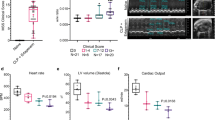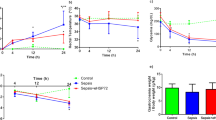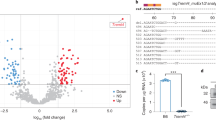Abstract
Sepsis is a complex, incompletely understood and often fatal disorder, typically accompanied by hypotension, that is considered to represent a dysregulated host response to infection. Neurotensin (NT) is a 13-amino-acid peptide that, among its multiple effects, induces hypotension. We find that intraperitoneal and plasma concentrations of NT are increased in mice after severe cecal ligation and puncture (CLP), a model of sepsis, and that mice treated with a pharmacological antagonist of NT, or NT-deficient mice, show reduced mortality during severe CLP. In mice, mast cells can degrade NT and reduce NT-induced hypotension and CLP-associated mortality, and optimal expression of these effects requires mast cell expression of neurotensin receptor 1 and neurolysin. These findings show that NT contributes to sepsis-related mortality in mice during severe CLP and that mast cells can lower NT concentrations, and suggest that mast cell–dependent reduction in NT levels contributes to the ability of mast cells to enhance survival after CLP.
This is a preview of subscription content, access via your institution
Access options
Subscribe to this journal
Receive 12 print issues and online access
$209.00 per year
only $17.42 per issue
Buy this article
- Purchase on Springer Link
- Instant access to full article PDF
Prices may be subject to local taxes which are calculated during checkout






Similar content being viewed by others
References
Martin, G.S., Mannino, D.M., Eaton, S. & Moss, M. The epidemiology of sepsis in the United States from 1979 through 2000. N. Engl. J. Med. 348, 1546–1554 (2003).
Angus, D.C. & Wax, R.S. Epidemiology of sepsis: an update. Crit. Care Med. 29, S109–S116 (2001).
Cohen, J. The immunopathogenesis of sepsis. Nature 420, 885–891 (2002).
Riedemann, N.C., Guo, R.F. & Ward, P.A. The enigma of sepsis. J. Clin. Invest. 112, 460–467 (2003).
Reinhart, K., Meisner, M. & Brunkhorst, F.M. Markers for sepsis diagnosis: what is useful? Crit. Care Clin. 22, 503–19 ix–x (2006).
Patel, G.P., Gurka, D.P. & Balk, R.A. New treatment strategies for severe sepsis and septic shock. Curr. Opin. Crit. Care 9, 390–396 (2003).
Vincent, J.L., de Carvalho, F.B. & De Backer, D. Management of septic shock. Ann. Med. 34, 606–613 (2002).
Tyler-McMahon, B.M., Boules, M. & Richelson, E. Neurotensin: peptide for the next millennium. Regul. Pept. 93, 125–136 (2000).
Remaury, A. et al. Targeted inactivation of the neurotensin type 1 receptor reveals its role in body temperature control and feeding behavior but not in analgesia. Brain Res. 953, 63–72 (2002).
Maeno, H. et al. Comparison of mice deficient in the high- or low-affinity neurotensin receptors, Ntsr1 or Ntsr2, reveals a novel function for Ntsr2 in thermal nociception. Brain Res. 998, 122–129 (2004).
Mazella, J. et al. The 100-kDa neurotensin receptor is gp95/sortilin, a non–G protein–coupled receptor. J. Biol. Chem. 273, 26273–26276 (1998).
Rioux, F., Kerouac, R., Quirion, R. & St-Pierre, S. Mechanisms of the cardiovascular effects of neurotensin. Ann. NY Acad. Sci. 400, 56–74 (1982).
Grocott-Mason, R.M. & Shah, A.M. Cardiac dysfunction in sepsis: new theories and clinical implications. Intensive Care Med. 24, 286–295 (1998).
Baker, C.C., Chaudry, I.H., Gaines, H.O. & Baue, A.E. Evaluation of factors affecting mortality rate after sepsis in a murine cecal ligation and puncture model. Surgery 94, 331–335 (1983).
Prodeus, A.P., Zhou, X., Maurer, M., Galli, S.J. & Carroll, M.C. Impaired mast cell-dependent natural immunity in complement C3-deficient mice. Nature 390, 172–175 (1997).
Supajatura, V. et al. Differential responses of mast cell Toll-like receptors 2 and 4 in allergy and innate immunity. J. Clin. Invest. 109, 1351–1359 (2002).
Maurer, M. et al. Mast cells promote homeostasis by limiting endothelin-1-induced toxicity. Nature 432, 512–516 (2004).
Malaviya, R., Gao, Z., Thankavel, K., van der Merwe, P.A. & Abraham, S.N. The mast cell tumor necrosis factor alpha response to FimH-expressing Escherichia coli is mediated by the glycosylphosphatidylinositol-anchored molecule CD48. Proc. Natl. Acad. Sci. USA 96, 8110–8115 (1999).
Echtenacher, B., Mannel, D.N. & Hultner, L. Critical protective role of mast cells in a model of acute septic peritonitis. Nature 381, 75–77 (1996).
Maurer, M. et al. The c-kit ligand, stem cell factor, can enhance innate immunity through effects on mast cells. J. Exp. Med. 188, 2343–2348 (1998).
Thakurdas, S.M. et al. The mast cell–restricted tryptase mMCP-6 has a critical immunoprotective role in bacterial infections. J. Biol. Chem. 282, 20809–20815 (2007).
Cochrane, D.E., Carraway, R.E., Boucher, W. & Feldberg, R.S. Rapid degradation of neurotensin by stimulated rat mast cells. Peptides 12, 1187–1194 (1991).
Goldstein, S.M., Leong, J. & Bunnett, N.W. Human mast cell proteases hydrolyze neurotensin, kinetensin and Leu5-enkephalin. Peptides 12, 995–1000 (1991).
Dobner, P.R., Fadel, J., Deitemeyer, N., Carraway, R.E. & Deutch, A.Y. Neurotensin-deficient mice show altered responses to antipsychotic drugs. Proc. Natl. Acad. Sci. USA 98, 8048–8053 (2001).
Kurose, M. & Saeki, K. Histamine release induced by neurotensin from rat peritoneal mast cells. Eur. J. Pharmacol. 76, 129–136 (1981).
Miller, L.A., Cochrane, D.E., Feldberg, R.S. & Carraway, R.E. Inhibition of neurotensin-stimulated mast cell secretion and carboxypeptidase A activity by the peptide inhibitor of carboxypeptidase A and neurotensin-receptor antagonist SR 48692. Int. Arch. Allergy Immunol. 116, 147–153 (1998).
Nakano, T. et al. Fate of bone marrow–derived cultured mast cells after intracutaneous, intraperitoneal, and intravenous transfer into genetically mast cell-deficient W/Wv mice. Evidence that cultured mast cells can give rise to both connective tissue type and mucosal mast cells. J. Exp. Med. 162, 1025–1043 (1985).
Gully, D. et al. Biochemical and pharmacological activities of SR 142948A, a new potent neurotensin receptor antagonist. J. Pharmacol. Exp. Ther. 280, 802–812 (1997).
Millican, P.E., Kenny, A.J. & Turner, A.J. Purification and properties of a neurotensin-degrading endopeptidase from pig brain. Biochem. J. 276, 583–591 (1991).
Barelli, H., Dive, V., Yiotakis, A., Vincent, J.P. & Checler, F. Potent inhibition of endopeptidase 24.16 and endopeptidase 24.15 by the phosphonamide peptide N-(phenylethylphosphonyl)-Gly-l-Pro-l-aminohexanoic acid. Biochem. J. 287, 621–625 (1992).
Powers, J.C. et al. Mammalian chymotrypsin-like enzymes. Comparative reactivities of rat mast cell proteases, human and dog skin chymases, and human cathepsin G with peptide 4-nitroanilide substrates and with peptide chloromethyl ketone and sulfonyl fluoride inhibitors. Biochemistry 24, 2048–2058 (1985).
Wilk, S. & Orlowski, M. Inhibition of rabbit brain prolyl endopeptidase by n-benzyloxycarbonyl-prolyl-prolinal, a transition state aldehyde inhibitor. J. Neurochem. 41, 69–75 (1983).
Tchougounova, E., Pejler, G. & Abrink, M. The chymase, mouse mast cell protease 4, constitutes the major chymotrypsin-like activity in peritoneum and ear tissue. A role for mouse mast cell protease 4 in thrombin regulation and fibronectin turnover. J. Exp. Med. 198, 423–431 (2003).
Shrimpton, C.N., Smith, A.I. & Lew, R.A. Soluble metalloendopeptidases and neuroendocrine signaling. Endocr. Rev. 23, 647–664 (2002).
Dauch, P., Vincent, J.P. & Checler, F. Specific inhibition of endopeptidase 24.16 by dipeptides. Eur. J. Biochem. 202, 269–276 (1991).
Feyerabend, T.B. et al. Loss of histochemical identity in mast cells lacking carboxypeptidase A. Mol. Cell. Biol. 25, 6199–6210 (2005).
Feldberg, R.S. et al. Evidence for a neurotensin receptor in rat serosal mast cells. Inflamm. Res. 47, 245–250 (1998).
Quirion, R., Rioux, F., Regoli, D. & St-Pierre, S. Compound 48/80 inhibits neurotensin-induced hypotension in rats. Life Sci. 27, 1889–1895 (1980).
Schaeffer, P. et al. Human umbilical vein endothelial cells express high affinity neurotensin receptors coupled to intracellular calcium release. J. Biol. Chem. 270, 3409–3413 (1995).
Schaeffer, P. et al. Neurotensin induces the release of prostacyclin from human umbilical vein endothelial cells in vitro and increases plasma prostacyclin levels in the rat. Eur. J. Pharmacol. 323, 215–221 (1997).
Norman, M.U., Reeve, S.B., Dive, V., Smith, A.I. & Lew, R.A. Endopeptidases 3.4.24.15 and 24.16 in endothelial cells: potential role in vasoactive peptide metabolism. Am. J. Physiol. Heart Circ. Physiol. 284, H1978–H1984 (2003).
Serafin, W.E., Dayton, E.T., Gravallese, P.M., Austen, K.F. & Stevens, R.L. Carboxypeptidase A in mouse mast cells. Identification, characterization, and use as a differentiation marker. J. Immunol. 139, 3771–3776 (1987).
Woodbury, R.G., Everitt, M.T. & Neurath, H. Mast cell proteases. Methods Enzymol. 80 Pt C 588–609 (1981).
Schwartz, L.B., Metcalfe, D.D., Miller, J.S., Earl, H. & Sullivan, T. Tryptase levels as an indicator of mast-cell activation in systemic anaphylaxis and mastocytosis. N. Engl. J. Med. 316, 1622–1626 (1987).
Fox, C.C., Dvorak, A.M., MacGlashan, D.W., Jr & Lichtenstein, L.M. Histamine-containing cells in human peritoneal fluid. J. Immunol. 132, 2177–2179 (1984).
Bienenstock, J. The mucosal immunologic network. Ann. Allergy 53, 535–540 (1984).
Metcalfe, D.D. Mast cell mediators with emphasis on intestinal mast cells. Ann. Allergy 53, 563–575 (1984).
Acknowledgements
We thank A. Xu and D. Lepard for technical assistance, M. Krupa-Plonowska and G. O'Riordan for their assistance with the collection of human blood samples, A. Patterson and R. Agrawal for the use of equipment to measure blood pressure and J. Kalesnikoff for critical reading of the manuscript. We thank B. Vincent (Institut de Pharmacologie Moleculaire et Cellulaire, Centre National de la Recherche Scientifique, Valbonne, France) for providing antibodies against NLN, M. Gurish (Brigham and Women's Hospital and Harvard Medical School, Boston, Massachusetts) for providing antibodies to mMCP-4 and mMCP-5, R. Carraway (University of Massachusetts Medical School, Worcester, Massachusetts) for providing antibodies to Ntsr1, V. Dive (Commissariat a L'Ennergie Atomique, Saclay, France) for providing phosphodiepryl-03, a NLN inhibitor that can be used with living cells, S. Wilk (Mount Sinai School of Medicine, New York) for providing CFp-Ala-Ala-Phe-pAB, L. Van Parijs (Massachusetts Institute of Technology) for providing pLentiLox 3.7 (pLL3.7), D. Gully (Sanofi-Synthelabo Recherche, Tolouse Cedex, France) for providing SR142948A and Amgen for the gifts of rat rSCF, human rSCF164 and human rIL-6. This work was supported by United States Public Health Science Grants (to S.J.G. and C.-C.C.), and by a fellowship from Deutsche Forschungsgemeinschaft (to M.M.).
Author information
Authors and Affiliations
Contributions
A.M.P., C.-C.C., T.N., E.J.R., P.R.D., J.D.F., R.G.P., M.T. and S.J.G. designed research; A.M.P., C.-C.C., T.N., M.M., E.J.R., S.Z. and U.M.M. performed research; A.M.P., C.-C.C., T.N., E.J.R., P.R.D., E.W., K.W., M.A., G.P., R.G.P., M.T. and S.J.G. analyzed data; A.M.P. and S.J.G. wrote the manuscript and C.-C.C., T.N., M.M., E.J.R., P.R.D., E.W., K.W., S.Z., U.M.M., J.D.F., M.A., G.P., R.G.P. and M.T. contributed to the revision and approval of the manuscript.
Corresponding author
Ethics declarations
Competing interests
Some authors of this manuscript (A.M.P., M.T. and S.J.G.) have filed a US patent entitled “Neurotensin as a marker and therapeutic target for sepsis” (patent 11/875,710). If issued, this patent will be assigned to Stanford University.
Supplementary information
Supplementary Text and Figures
Supplementary Figs. 1–10, Supplementary Table 1 and Supplementary Methods (PDF 572 kb)
Rights and permissions
About this article
Cite this article
Piliponsky, A., Chen, CC., Nishimura, T. et al. Neurotensin increases mortality and mast cells reduce neurotensin levels in a mouse model of sepsis. Nat Med 14, 392–398 (2008). https://doi.org/10.1038/nm1738
Received:
Accepted:
Published:
Issue Date:
DOI: https://doi.org/10.1038/nm1738
This article is cited by
-
Detection of orthodontically induced inflammatory root resorption-associated biomarkers from the gingival crevicular fluid by proteomics analysis: a randomized-controlled clinical trial
3 Biotech (2023)
-
Modulators of neurolysin: promising agents for the treatment of tumor and neurological diseases
Medicinal Chemistry Research (2021)
-
Glycogen metabolism regulates macrophage-mediated acute inflammatory responses
Nature Communications (2020)
-
Mast cells and IgE in defense against lethality of venoms: Possible “benefit” of allergy
Allergo Journal International (2020)
-
Mast cells and IgE in defense against lethality of venoms: Possible "benefit" of allergy*
Allergo Journal (2020)



